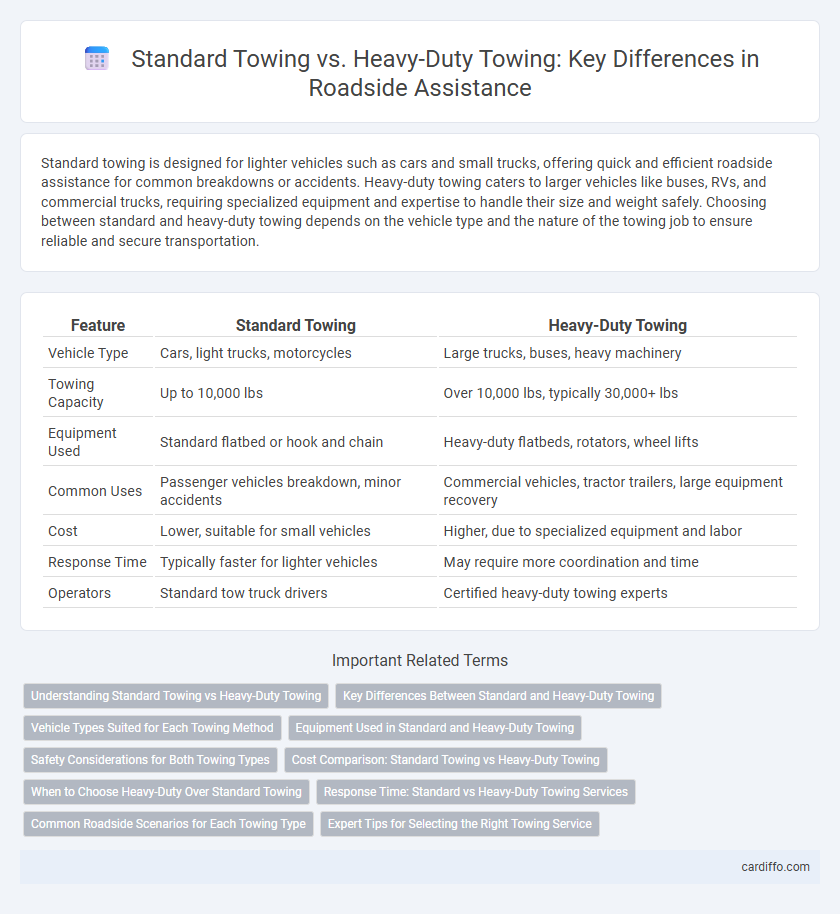Standard towing is designed for lighter vehicles such as cars and small trucks, offering quick and efficient roadside assistance for common breakdowns or accidents. Heavy-duty towing caters to larger vehicles like buses, RVs, and commercial trucks, requiring specialized equipment and expertise to handle their size and weight safely. Choosing between standard and heavy-duty towing depends on the vehicle type and the nature of the towing job to ensure reliable and secure transportation.
Table of Comparison
| Feature | Standard Towing | Heavy-Duty Towing |
|---|---|---|
| Vehicle Type | Cars, light trucks, motorcycles | Large trucks, buses, heavy machinery |
| Towing Capacity | Up to 10,000 lbs | Over 10,000 lbs, typically 30,000+ lbs |
| Equipment Used | Standard flatbed or hook and chain | Heavy-duty flatbeds, rotators, wheel lifts |
| Common Uses | Passenger vehicles breakdown, minor accidents | Commercial vehicles, tractor trailers, large equipment recovery |
| Cost | Lower, suitable for small vehicles | Higher, due to specialized equipment and labor |
| Response Time | Typically faster for lighter vehicles | May require more coordination and time |
| Operators | Standard tow truck drivers | Certified heavy-duty towing experts |
Understanding Standard Towing vs Heavy-Duty Towing
Standard towing services typically handle vehicles weighing up to 10,000 pounds, such as sedans, SUVs, and small trucks, using light to medium-duty tow trucks. Heavy-duty towing involves specialized equipment designed for larger vehicles exceeding 25,000 pounds, including buses, semi-trucks, and construction machinery. Understanding the difference ensures the appropriate towing method is applied, optimizing safety and efficiency on the roadside.
Key Differences Between Standard and Heavy-Duty Towing
Standard towing services typically handle vehicles weighing up to 10,000 pounds, including cars, motorcycles, and light trucks, using lighter tow trucks such as flatbeds or wheel-lift tow trucks. Heavy-duty towing involves recovering and transporting large vehicles like buses, RVs, and commercial trucks exceeding 26,000 pounds, requiring specialized equipment such as rotator tow trucks and heavy-duty wreckers. Key differences include towing capacity, equipment size, and operational techniques tailored to the weight and size of the vehicle being towed.
Vehicle Types Suited for Each Towing Method
Standard towing is best suited for light- to mid-sized vehicles such as sedans, SUVs, and small trucks, using methods like flatbed or wheel-lift towing to ensure minimal wear. Heavy-duty towing caters to larger vehicles including commercial trucks, buses, and oversized RVs, employing robust equipment like boom and integrated tow trucks designed to handle high weight capacities safely. Selecting the appropriate towing method based on vehicle type reduces damage risk and enhances roadside recovery efficiency.
Equipment Used in Standard and Heavy-Duty Towing
Standard towing employs light-duty equipment such as wheel lifts, tow dollies, and flatbed trucks designed for compact cars and small SUVs. Heavy-duty towing utilizes robust machinery like integrated wreckers, rotators, and hydraulic cranes capable of handling large commercial vehicles, buses, and heavy machinery. The distinction in equipment ensures efficient and safe recovery tailored to the vehicle's size and weight class.
Safety Considerations for Both Towing Types
Standard towing prioritizes safety by ensuring proper weight distribution and secure attachment with certified equipment to prevent accidents on highways and urban roads. Heavy-duty towing involves rigorous safety measures, including the use of specialized vehicles and reinforced towing rigs designed to handle the increased load of large trucks or machinery, reducing risks during transport. Both towing types require compliance with legal weight limits and regular inspections to maintain optimal braking and stability on various terrains.
Cost Comparison: Standard Towing vs Heavy-Duty Towing
Standard towing typically costs between $75 and $125 for light vehicles, while heavy-duty towing for large trucks or buses ranges from $150 to over $500 due to the specialized equipment and increased labor required. Factors such as vehicle size, weight, and terrain significantly impact pricing, with heavy-duty towing demanding reinforced tow trucks and additional personnel. Choosing the appropriate towing service ensures cost efficiency and safety based on the vehicle's specific needs.
When to Choose Heavy-Duty Over Standard Towing
Heavy-duty towing is essential when transporting oversized or exceptionally heavy vehicles such as large trucks, buses, or construction equipment that exceed the weight limits of standard towing services, typically above 15,000 pounds. Opt for heavy-duty towing if the vehicle's weight or size surpasses standard tow trucks' capacity, ensuring safety and preventing equipment damage. Specialized heavy-duty tow trucks equipped with reinforced frames, stronger winches, and higher towing power provide the necessary support for challenging roadside recoveries and transport needs.
Response Time: Standard vs Heavy-Duty Towing Services
Standard towing services typically offer faster response times, often arriving within 30 minutes due to lighter equipment and less complex dispatch requirements. Heavy-duty towing requires more specialized vehicles and personnel, which can extend response times to 45 minutes or more, especially for large trucks or industrial equipment. Emergency roadside assistance centers prioritize dispatch based on vehicle type and situation severity, influencing overall response efficiency.
Common Roadside Scenarios for Each Towing Type
Standard towing is ideal for common roadside scenarios such as light vehicle breakdowns, minor accidents, and flat tires where passenger cars and smaller SUVs need quick assistance. Heavy-duty towing handles severe situations involving commercial trucks, buses, and large recreational vehicles stuck due to accidents, mechanical failure, or heavy loads that exceed standard towing capacity. Proper identification of the vehicle type and the towing requirements ensures safe and efficient roadside recovery under varying conditions.
Expert Tips for Selecting the Right Towing Service
Expert tips for selecting the right towing service emphasize understanding the weight and size of your vehicle: standard towing suits passenger cars and light trucks up to 7,500 pounds, while heavy-duty towing is essential for large trucks and buses exceeding that weight. Always verify that the towing company has equipment rated for your vehicle's load to prevent damage and ensure safety. Confirm the provider's experience with your specific vehicle type and inquire about licensing, insurance, and response times for reliable roadside assistance.
standard towing vs heavy-duty towing Infographic

 cardiffo.com
cardiffo.com